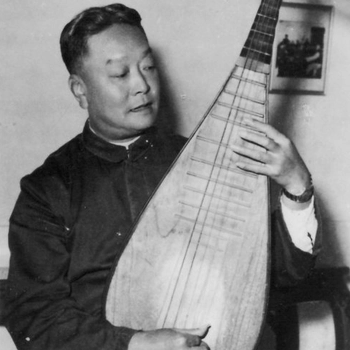Li Yansong
Organized by 陆晨 on 2022-03-29

Li Tingsong was originally from Suzhou, Jiangsu. In his youth, he loved folk music. He studied from the famous Pipa master Wang Yuting, and was highly valued by his teacher. In 1924, he participated in the Shanghai Chinese Music Research Association. In 1925, he invited some like-minded people to initiate and organize the Xiao Chinese Music Society and served as the president. It was he who modified the ancient song "The Overlord Unloads Armor". Show the style of the song vividly.
After the outbreak of the Anti-Japanese War in 1937, he left Shanghai and traveled to Yunnan and Sichuan to participate in charity performances, which were warmly welcomed by the masses. After the founding of the People's Republic of China, Li Tingsong was hired as a special performer of the Institute of Ethnic Music of the Central Conservatory of Music, and successively taught at the Central Conservatory of Music, Tianjin Conservatory of Music, Shenyang Conservatory of Music and other schools. He has participated in the Chinese folk and classical music tour troupe organized by the Chinese Musicians Association and performed in major cities. His pipa performance is known for his martial arts, the style is simple and profound, strong and straight, and the music is handled in a simple way, echoing before and after, all in one.
Since the 1950s, he has performed traditional ancient songs such as "The Overlord Unleashes Armor", "House of Flying Daggers", "Xiao Drum in the Sunset", and "Qinglian Yuefu". The China Record Society also recorded some of his pipa music into records. In teaching, he emphasizes teaching students in accordance with their aptitude, focusing on practical results, and improving students' comprehension ability and art appreciation level in a targeted manner.
Similar artist
LAN Weiwei, born in May 1980, studied at the Affiliated Middle School of Sichuan Conservatory of Music from 1992 to 1998. She has long been the chief of the strumming section of the Youth Chinese Orchestra of the Central Conservatory of Music.
read >>
Yu Yuanchun, female, teacher of the Central Conservatory of Music, the first doctor of pipa from the Central Conservatory of Music, director of the Chinese Ethnic Orchestral Society, pipa player of the National Orchestra of China, UNESCO special artist.
read >>
Wu Bing, a pipa player, a Chinese living in France, the first recipient of the "Angel of Chinese Culture" who spread Chinese culture in France.
read >>
Graduated from Sichuan Conservatory of Music majoring in pipa, he is more beautiful than Qin Huai, and the master of Pipa Up at station B: Jumo Peanut Butter. Is a new generation of traditional Chinese music performers.
read >>
Zhang Yadi is a young Chinese pipa performer, a pipa teacher at Tianjin Conservatory of Music, a master’s degree from the Central Conservatory of Music, and the first BOB top-notch innovative talent of the Central Conservatory of Music.
read >>
Involving musical instruments
Pipa (pinyin: pí pa), the first plucked instrument, is a traditional plucked instrument in East Asia, a plucked stringed musical instrument. Made of wood or bamboo, the speaker is half-pear-shaped and has four strings on the top. It was originally made of silk thread, but now it is mostly made of steel wire, steel rope and nylon.
Involved portfolio
Involved news
Organized by 岚玖 on 2024-02-23
"Sunset Xiao Gu", also known as "Xunyang Night Moon" or "Spring River Flower Moon Night", is a highly representative classic of ancient Chinese pipa music.
read >>
Organized by ky on 2024-02-20
Pipeggio "Flying Flowers" is a very poetic and pictorial masterpiece in traditional Chinese music. With its fresh and elegant melody, it shows the exquisite description and unique feeling of the ancient literati on the beauty of nature.
read >>
Organized by 年糕 on 2024-02-20
The Piarpeggio "Zhaojun Out" is a masterpiece of historical significance and dramatic tension in traditional Chinese music. It narrates the historical event of Wang Zhaojun, one of the four beautiful women in ancient China, marrying Xiongnu and promoting peace between Han and Hungary with rich musical language.
read >>
Organized by 爱在西元 on 2024-02-20
The pipeggio "Yueergao" is one of the most popular songs in Chinese classical music. It is loved by many music fans for its melodious and profound artistic conception. This song originated from the Pipa song of the Ming and Qing dynasties. Through the unique musical language, it depicts a picture of peace and tranquility under the bright moonlight.
read >>
Organized by 薄暮 on 2024-02-20
The pipa solo "Snow in the Spring" is a shining pearl in the treasure house of Chinese national music, and is a classic pipa masterpiece that has been passed down through the ages and enjoys worldwide fame. Its name comes from Song Yu's "Ask the King of Chu" in the Warring States Period, which symbolizes the elegant and delicate artistic realm, profound meaning and beautiful melody, and has always been regarded as the best pipa art of "Yangchun Snow" style.
read >>

 渝公网安备 50010702504639号
渝公网安备 50010702504639号